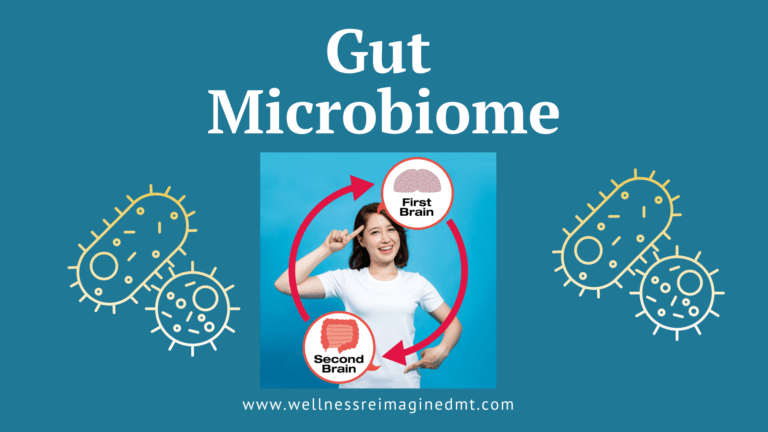Gut Microbiome
The Gut Brain Axis and How it Effects Your Mental Health

Ever wonder why some foods make you feel good physically and mentally? Some of that is due in part to the gut-brain axis! What is the gut-brain axis, and how does it influence the rest of your body – and even your mood?
The Gut Microbiome
To understand the gut-brain axis, you have to know about the gut microbiome. The gut microbiome plays such a prominent role in body functions that scientists are starting to call it another organ. Microbiome means “small community in a habitat.” In this case, that habitat is your gut: mainly your large intestine, or colon, and your small intestine. Our body holds trillions of helpful bacteria that we gain over a lifetime, and every person’s gut microbiome is unique: in variety, number, and makeup.
What Makes Your Gut Microbiome Unique to You
What forms a person’s unique gut microbiome? Bacterial colonization of the gut starts from birth, as the way humans are born can influence the bacteria. Breastfeeding or formula feeding plays a role in which types of bacteria become common or dominant. Breastfeeding provides more immune benefits and beneficial bacteria than bottle or formula feeding.1 As a person ages, food, medication, illness, pets and animals, and the way their body operates affect what bacteria thrive in their gut and are unique to the individual.2, 3
The Gut Microbiome’s Effect on Health
How does the gut microbiome affect a person’s health? One of the gut microbiome’s most significant roles is to break down and ferment dietary fiber. So yes, those little guys are responsible for how you feel after eating baked beans! But that process is a good thing because, in addition to making gas, it creates short-chain fatty acids (SCFAs). SCFAs play several roles in the body and may help regulate appetite and food intake, provide energy for cells in your intestines, help in anti-inflammatory processes, and even reduce spikes in blood glucose after a meal.2, 3
So that’s how the gut microbiome works. Understanding what the gut microbiome does is important because it’s a large part of the gut-brain axis. Not only does the brain influence the gut, but the gut and gut microbiome can influence the brain! This gut and gut microbiome interaction occurs through the central nervous system (CNS): your brain and spinal cord, and the Enteric Nervous System (ENS): the nerves that connect with parts of your digestive tract.4 Research has revealed that the gut microbiome plays a role in digestive function and satiety.2, 3, 4 We’ve also learned that an abnormal gut-brain connection can cause inflammation in the gut, altered responses to stress, and altered behavioral states.4 Remember those SCFAs? They positively affect the brain by helping with immunity and protecting the blood-brain barrier, a barrier between the brain and blood that only allows specific molecules into the brain.4
The Gut-Brain Axis
However, the gut-brain axis is a bit of a chicken and egg situation. Does an altered gut affect how we feel? Or does stress lead to adverse effects on the gut? The answer is both! Stress, changes in diet, and antibiotics can lead to changes in the makeup of a person’s gut microbiome.5 Those same factors can cause the spaces between the cells in the gut lining to loosen and allow bacterial products and the bacteria themselves to leak through into the bloodstream, a problem appropriately called leaky gut syndrome.5 Inflammation can also affect the gut microbiome and brain by releasing pro-inflammatory factors that put stress on the microbiome and loosen gaps in the blood-brain barrier, leading to anxiety, depression, and memory loss.5
How to Eat for a Healthy Gut
Researchers are still studying what is beneficial for the gut microbiome. Currently, there is no one way of eating for gut microbiome health, and there likely never will be: the gut microbiome is so unique to an individual that there is no one “perfect” diet for all. However, we do know some foods can help support your gut microbiome. They generally fall into two categories: prebiotics and probiotics.
Prebiotic Foods
Prebiotics are specific types of fiber that are essentially food for certain bacteria.3
Common prebiotic foods include garlic, onions, leeks, asparagus, less ripe bananas, barley, oats, apples, cocoa powder, flaxseeds, wheat bran, and seaweed. Eating foods with any kind of fiber, in general, is also good for the health of the gut microbiome and overall gut health and cardiovascular health!
Probiotic Foods
Probiotics are live microorganisms that can have a beneficial effect on your health when taken in safe amounts.3 Probiotics can be found in foods and supplements.
Typical probiotic foods are yogurt, kefir, sauerkraut, tempeh, miso, and raw/unpasteurized kombucha. You can take probiotics in supplement form, but it’s worth talking to your doctor or dietitian about which strain might be best for you before adding them to your routine.
In Summary
The gut-brain axis is a complicated system with new research coming out constantly. At the very least, we know that the gut microbiome influences mental and physical health. If you don’t recognize any prebiotic or probiotic foods mentioned above as part of your diet, consider adding them to your meals. By improving your nutrition, you can impact your gut microbiome and enhance your health.
By changing your nutrition, you can positively impact your gut microbiome.
Want to know how to improve your gut microbiome? Schedule a free 30-minute consult.
Thank you to Emmalee Calvert, a dietetic intern, who wrote a majority of this article for mental health month.
Major Sources
1. Fehr, K., Mossavi, S., Sbihi, H., Boutin, R. C. T., Bode, L., Robertson, B., Yonemitsu, C., Field, C. J., Becker, A. B., Mandhane, P. J., Sears, M. R., Khafipour, E., Moraes, T. J., Subbarao, P., Finlay, B. B., Turvey, S. E., Azad, M. B. (2020, August). Breastfeeding feeding practices are associated with the co-occurence of bacteria in mothers’ milk and the infant gut: The CHILD cohort study. Cell Host & Microbe, 28(2). 285-297. https://www.cell.com/cell-host-microbe/fulltext/S1931-3128(20)30350-4
2. Milani, C., Ferrario, C., Turroni, F., Duranti, S., Mangifesta, M., van Sinderen, D., & Ventura, M. (2016). The human gut microbiota and its interactive connections to diet. Journal of Human Nutrition & Diet, 29. 539-546. doi.org/10.1111/jhn.12371
3. Valdes, A. M., Walter, J., Segal, E., & Spector, T. D. (2018). Role of the gut microbiota in nutrition and health. British Medical Journal, 361(Supp1). 36-41. doi.org/10.1136/bmj.k2179
4. Cryan, J. F., O’Riordan, K. J., Cowan, C. S. M., Sandhu, K. V., Bastiaanssen, T. F. S., Boehme, M., Codagnone, M. G., Cussotto, S., Fulling, C., Golubeva, A. V., Guzzetta, K. E., Jaggar, M., Long-Smith, C. M., Lyte, J. M., Martin, J. A., Molinero-Perez, A., Moloney, G., Morelli, E., Morillas, E., O’Connor, R., Cruz-Pereira, J. S., Peterson, V. L., Rea, K., Ritz, N. L., Sherwin, E., Spichak, S., Teichman, E. M., van de Wouw, M., Ventura-Silva, A. P., Wallace-Fitzsimons, S. E., Hyland, N., Clarke, G., & Dinan, T. G. (2019). The microbiota-gut brain axis. Physiological Reviews 99(4). 1877-2013. https://journals.physiology.org/action/showCitFormats?doi=10.1152%2Fphysrev.00018.2018
5. Clapp, M., Aurora, N., Herrer, L., Bhatia, M., Wilen, E., & Wakefield, S. (2017). Gut microbiota’s effect on mental health: The gut-brain axis. Clinical Practice, (7)4: 987. https://www.ncbi.nlm.nih.gov/pmc/articles/PMC5641835/
